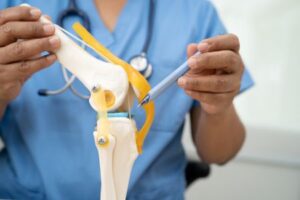OSTEOARTHRITIS
If you suffer from osteoarthritis, please Schedule an appointment with one of our orthopedic specialists as soon as possible.
 What is Osteoarthritis?
What is Osteoarthritis?
Osteoarthritis occurs when the protective cartilage that cushions your joints gradually wears away. Without that smooth surface, bones begin to rub against each other, causing pain, stiffness, and a reduced range of motion. Although osteoarthritis can affect almost any joint, it most often develops in the knees, hips, spine, hands, and shoulders.
This degenerative process can begin slowly and worsen over time. While aging is the most common factor, osteoarthritis is not simply a result of “wear and tear.” Repetitive stress, past injury, or mechanical imbalance can all contribute to the breakdown of cartilage and inflammation within the joint. Early evaluation by an orthopedic specialist helps identify the affected joints and determine the most effective course of treatment for relief.
Causes and Risk Factors of Osteoarthritis
Several factors can increase your risk of developing osteoarthritis:
-
Previous joint injury or surgery
-
Repetitive overuse or occupational strain
-
Genetic predisposition to cartilage degeneration
-
Obesity or excess body weight
-
Muscle weakness and poor joint alignment
-
Aging and decreased joint hydration
In some cases, osteoarthritis may occur with other conditions, such as rheumatoid arthritis, scoliosis, or degenerative disc disease, that affect spinal alignment and joint balance.
Common Symptoms
Osteoarthritis symptoms can vary depending on the joint involved, but often include:
-
Pain or aching that worsens with activity or at the end of the day
-
Stiffness after resting or waking up
-
Swelling or tenderness around the joint
-
A sensation of grinding or “bone-on-bone” movement
-
Reduced flexibility and difficulty completing daily tasks
If you notice consistent joint pain or stiffness that lasts longer than a few weeks, consult a joint specialist. Early treatment can slow progression and reduce long-term discomfort.
Diagnosis
An orthopedic specialist can diagnose osteoarthritis through a physical exam and imaging studies such as X-rays or MRI scans. These tests help reveal cartilage loss, bone spurs, and narrowing of the joint space. Evaluating your symptoms and activity level allows your provider to design a treatment plan tailored to your needs and goals.
What are the Treatment Options for Osteoarthritis?
Although medicine cannot reverse osteoarthritis, various treatments exist to help manage symptoms and improve function. At Texas Orthopedic & Spine Associates, we focus on evidence-based therapies designed to restore movement, reduce pain, and enhance quality of life.
Non-surgical treatments may include:
-
Physical therapy and guided exercise programs to strengthen muscles and improve joint mechanics
-
Anti-inflammatory or pain-relief medications
-
Weight management and low-impact aerobic activity
-
Bracing or assistive devices to reduce joint strain
-
Joint injections, such as corticosteroids or hyaluronic acid, are used to reduce inflammation and cushion the joint
-
Occupational therapy to support daily function and ergonomics
If conservative measures do not provide lasting relief, your specialist may discuss surgical options such as joint replacement or arthroscopic procedures to repair damaged tissue. The goal is to alleviate pain, restore proper alignment, and enhance long-term stability.
Preventing Osteoarthritis Progression
You can slow the progression of osteoarthritis by maintaining an active lifestyle, avoiding high-impact activities that stress your joints, and staying within a healthy weight range. Regular stretching, strengthening, and posture training can protect cartilage and support joint health. Your provider may recommend periodic follow-ups to adjust your care plan as needed.
When to Seek Specialist Care
Persistent joint pain, swelling, or stiffness that interferes with your everyday activities warrants evaluation. At Texas Orthopedic & Spine Associates, our multidisciplinary team provides advanced diagnostics and comprehensive treatment to help patients regain mobility and confidence.

